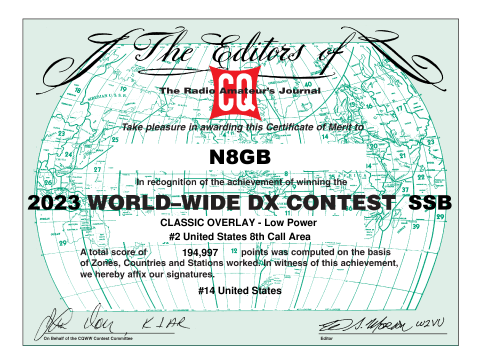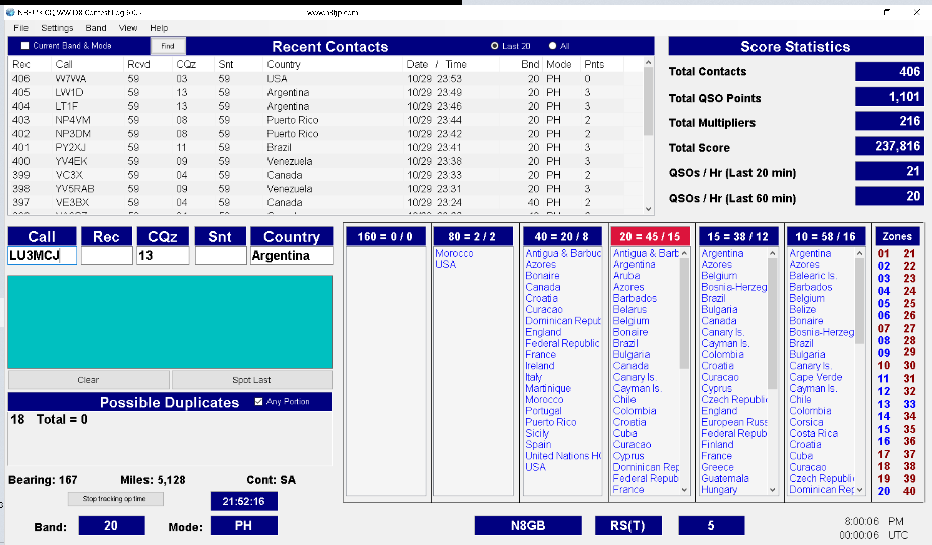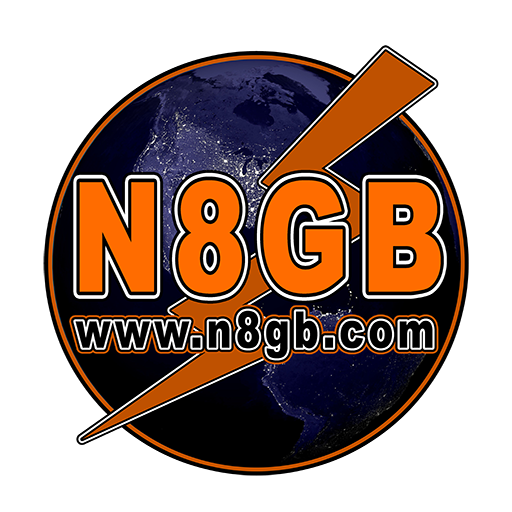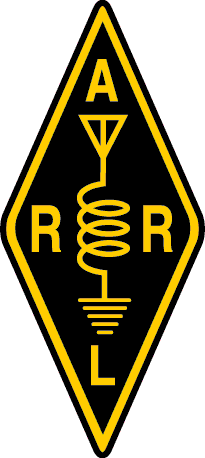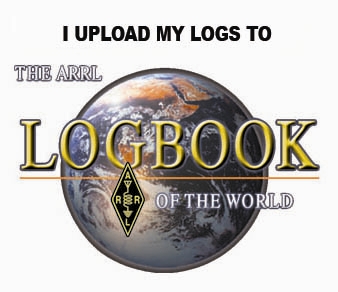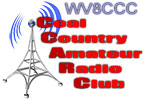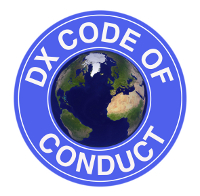Contesting
UPDATE:
The final results are in for the big amateur radio contest we participated in recently (CQWW SSB – https://www.cqww.com/index.htm) , here’s the final results. In my class of participation, which is the classic/low power group, the end results in each area, starting in the calling area we’re in and going up to the World are on the left of each line below:
W8 Calling Area (includes WV, Ohio and Michigan):
#2 of 19 Participants in the Classic/Lower Power Categories.
United States:
#14 of 173 Participants in the Classic/Lower Power Categories.
NORTH AMERICA (U.S. Canada, Mexico, Central America and many Caribbean Nations):
#155 of 2027 Participants in the Classic/Lower Power Categories.
World:
#1530 of 7396 Participants in the Classic/Lower Power Categories.
Out of the 9638 participants in all categories, I scored #2071
Not too shabby for my first real contest, I’ve worked contests before, but not with any amount of real dedication. My stats show I worked for 17+ hours out of 48, but that’s not really the case as I left the counter turned on for several hours, so the time is skewed. I worked for around 12 hours or so out of the 48.
I am not big into contesting, but I really enjoy participating. I will never be able to afford one of those big stations with multiple towers, multiple multi-band antennas, amplifiers, etc. I am however, very successful in the way I make contacts with the equipment I have.
I have what I consider to be slightly above a basic setup. My home station consists of the following:
- Yaesu FTdx1200 w/ FH-2 Remote Control Keypad & DVS-6 Voice Memory Unit (I did not use this for the recent 2023 CQ WW SSB contest)
- LDG AT-600 ProII Tuner (I don’t use it in “automatic mode”)
- N4RR (K4HEX) Hexbeam Antenna (6-20m)
- G6RV + ladder line (30/40/80m)
- RG-8x feed line
- Heil Pro 7 Headset (EXTREMELY IMPORTANT to have a good headset)
“Basic” would cut the headset and the hexbeam, otherwise, a radio, a tuner, a wire antenna and feedline and you can do just about everything, but not quite as well as you can do it with adding a hexbeam and a headset. The headset is the most important add-on to the “basic” lineup, without it, you will not be able to (more easily) pull in distant DX stations out of the white noise, with it, and by using whatever filters are available to you on the radio, you’ll be able to single out DX stations which in turn, gives you additional multipliers for contesting.
This past weekend, October 28/29 2023, I participated in the CQ World Wide DX SSB contest and I had a blast. I made 406 contacts and with the multipliers (countries and zones) these contacts resulted in a little more than 227,000 points. I am happy with that result. It took a lot of work. I was in the “classic” category and could only work (to maintain classic) 24 hours or less in the contest (48 hours possible). I worked around 12 hours or so, give or take (it shows 17+ on my CQ WW log, but I accidentally left the timer on for a few hours that I wasn’t working).
Here are some tips that may help you with isolating DX contacts:
- Headset. Get a good one and use it. Doesn’t have to have a mic, any good quality headset will work, just adapt the plug to match your rig and use it.
- Learn your filters or get some filters for your radio if you don’t have them. Using good receive filters to isolate the incoming signal helps tremendously. Whether you’re using DNF (dynamic noise filtering), NR (Noise Reduction), audio pre-amplifiers, roofing filters, notch, contour, width or shift, or a variety of all, learn how to use your rig to better your advantage to hearing contacts. This isn’t your every-night-rag-chew (more about that later). You’re going to hear stations in ways you normally wouldn’t want to hear them. Compression helps with DX, so many stations compress their outbound audio to a lesser bandwidth. This helps save bandwidth and it also makes it easier to hear in varying conditions. Higher frequency voices are more intelligible than deeper voices during contesting.
- Do not dismiss relatively tough-to-hear contacts, just because you can’t hear them, doesn’t mean they won’t be able to hear you. Your antenna propagation may be pointed directly at them while they’re pointed away from you. There’s a variety of reasons, any of which can earn you a contact!
- Stop worrying about stepping on someone. If you try to “wait your turn”, you will never get a turn. Jump in there and throw out your callsign, as clearly as you can, while doing it quickly. Match the speed of the contact, if they’re speaking quickly, speak quickly to them, they can handle it. Someone that speaks quickly can hear that which is spoken to them quickly. Pay attention to the caller’s cadence, notice how they end their call, “…cq contest, n8gb.” If they do it once, they’ll usually repeat the pattern, be ready on the PTT the instant, or just before the end of their call and GET WITH IT, stop hesitating.
- Big boomer stations don’t always have the best reception. They may be +20db over 9 on your meter, but that doesn’t mean they can hear well – or – they’re putting out more power than necessary for the operation at-hand and don’t have the ability to hear from the area receiving them. Try to isolate stations that don’t register so high on your meter, stations that you can hear but doesn’t sound like they’re using a 10kw military amp. Low power stations (<100w) are within range of other low power stations (above QRP). Some high power stations are not within range of low power stations.
- Learn what to listen for. When running 20m or above, everything is USB. If you start from the bottom of the band, 14.150 and work your way up, transmitting stations will have a higher pitch on the lower frequencies and lower pitch on the higher frequencies (above/below their working frequency). While moving your VFO up the frequencies, you will first hear their higher pitch TX and it will gradually get lower and intelligible. Don’t try to match their exact frequency, it’s usually easier, especially on low power DX stations, to understand them if you’re about 100khz BELOW their transmit frequency.
-
-
-
- Pay attention to their callsign, try to nail that down before responding to them.
- Know exactly what you’re going to say:
- You only respond with your callsign, they’re listening for callsigns and nothing else.
- Once they acknowledge your callsign by repeating it, confirm with “ROGER ROGER”, then….
- Give them the data for the contest. For the CQ contest, it’s signal report + CQ zone. My CQ zone is 5, I would then give them back “ROGER ROGER 5-9 <pause> 5”, they’ll give you your report. If you’re good with that, you don’t need to end the call if you don’t want to, you keep moving up the dial. Done. If you didn’t hear them, use “REPEAT REPEAT” and they’ll give it again. If you missed their callsign, hang around for a bit, they’ll give it out to someone else shortly.
-
-
-
- The opposite is true for working down the band. Lower pitch at higher frequencies. It’s a little tougher for me to discern the words when the pitch is lower, so I typically operate from lower to higher frequencies, but occasionally I’ll work down, which usually makes me drop below them, listen, then get to within 100khz below, then attempt contact.
- Hang in there. Once again, listen to their cadence and throw out your callsign when appropriate. Keep after it for a little bit. If they’re using “QRZ” as an indicator they’re ready for the next call, make sure to jump in there after they say “QRZ”. Get the call established, then worry about getting their callsign, either by simply asking them to “REPEAT YOUR CALLSIGN” or just wait, they’ll give it out in a bit.
- Use a good logging program such as those from N3JFP. I paid for the entire package and it’s “for life”, and I get all of his loggers. Pay attention to the different attributes of the fields you’re using for the logging, those attributes will give you hints about what station you’re working. Whether it’s a duplicate or it’s a new zone, grid, country, etc. And that’s IMPORTANT. In CQ WW SSB, countries and zones are MULTIPLIERS. Contacting multiple people on your zone doesn’t help you in CQ WW SSB, no points, no multipliers after the first contact withing your zone you get.
- Read the rules for the contest and use them to your advantage.
- In the CQ WW SSB contest, if you’re new to contesting and from WV, chances are, your callsign will not have the proper zone pre-filled in N3FJP (and maybe other) loggers. You will need to argue with some contacts that you’re in zone 5. It’s on them to take down the proper info and doesn’t affect your score in the end. It affects THEIR score, so don’t put a lot of weight into the argument. Give it to them, roger-roger it, and move on. If they leave you a zone 4, that’s their problem and doesn’t affect the final outcome FOR YOU (I spoke to N3FJP and Jim, the person that puts out the zone info for a lot of the software developers to use about this situation).
- Spotting networks work, such as DXSummit.fi, however, I don’t use them for contesting. I just work from bottom-to-top of the band (or vice-versa) and listen hard, trying everyone I can hear enough to make out their callsign.
- There’s nothing you can do to counter splatter, pirate broadcast stations, trouble-makers or LID operators. Get over it. Don’t cave in to the frustration. Move along and forget them. Getting frustrated and trying to vent your frustrations either on or off the air doesn’t help your score.
- Take breaks. Go walk around, go to the store, go play with the dogs. Don’t sit there like a knot on a log. For your own health, mentally and physically, take breaks.
Here’s more info concerning DX Stations, which will assist in some of the contests you may take part.
As always, adhere to the DX Code of Conduct:
- I will listen, and listen, and then listen again before calling.
- I will only call if I can copy the DX station properly.
- I will not trust the DX cluster and will be sure of the DX station’s call sign before calling.
- I will not interfere with the DX station nor anyone calling and will never tune up on the DX frequency or in the QSX slot.
- I will wait for the DX station to end a contact before I call.
- I will always send my full call sign.
- I will call and then listen for a reasonable interval.
- I will not call continuously.
- I will not transmit when the DX operator calls another call sign, not mine.
- I will not transmit when the DX station requests geographic areas other than mine.
- When the DX operator calls me, I will not repeat my call sign unless I think he has copied it incorrectly.
- I will be thankful if and when I do make a contact.
- I will respect my fellow hams and conduct myself so as to earn their respect.
